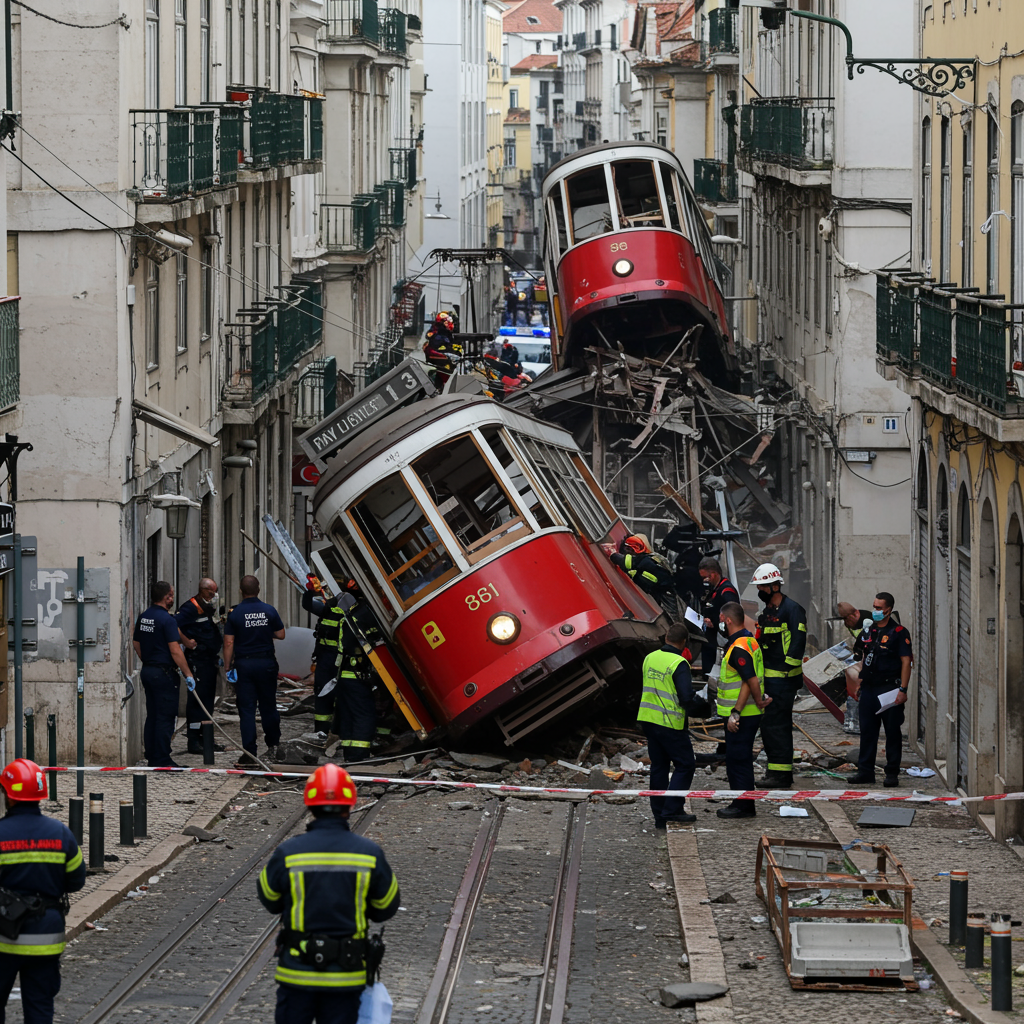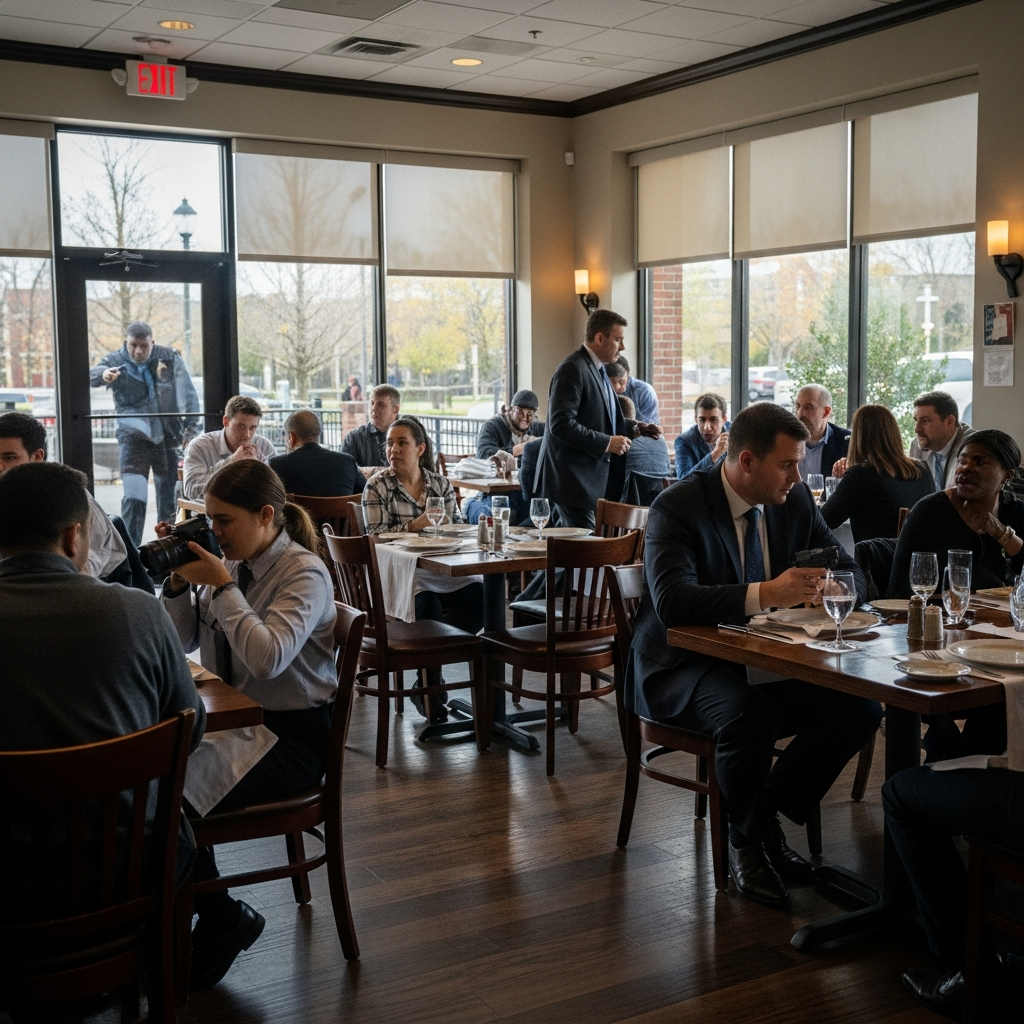The vibrant heart of Lisbon was shattered on September 3, 2025, when the historic Elevador da Glória funicular suffered a catastrophic derailment. This devastating incident, which saw the popular tourist tram crash into a building on Avenida da Liberdade, claimed the lives of 16 people and left 21-23 injured, sending shockwaves across Portugal and beyond. As the city grapples with profound grief, an urgent investigation is underway to uncover why one of its cherished national monuments became the site of such immense tragedy. This article delves into the harrowing details, the international impact, and the critical questions now facing Lisbon’s transport safety and tourism future.
The Day Tragedy Struck Lisbon’s Heart
Wednesday evening descended into chaos in central Lisbon. António Azevedo, a local tuk-tuk driver, initially dismissed a sound like “dozens of glass containers being dropped” as typical city noise. However, the sight of smoke billowing from the Elevador da Glória’s lower station quickly revealed a far grimmer reality. Azevedo, along with other business owners, raced to the scene.
What they encountered was a scene of unimaginable horror. The funicular, a symbol of Lisbon’s charm, was a mangled wreck. Disoriented amidst the screams and cries, initial helpers bravely attempted to rescue survivors. Mohammad Farid, a souvenir store owner, arrived hoping to save lives. Yet, for many, it was already too late.
Azevedo himself held a bleeding young boy, crying for his father, before police and firefighters took over. He recalled a chilling shift from frantic noise to an eerie silence. “There was a mountain of bodies that were not asking for help,” he recounted, describing victims “torn apart.” Farid echoed the grim reality: “No one was asking for help because they were dead. They were dead in seconds.” The wreckage, primarily metal, lay crumpled, its sides and top crushed. Emergency officials managed to pull all victims from the wreckage within just over two hours.
A City in Mourning, A Nation Shaken
The immediate aftermath saw Lisbon plunged into collective grief. Portugal’s Prime Minister Luís Montenegro declared a national day of mourning, calling the incident “one of the biggest tragedies in our recent history.” The site of the accident quickly transformed into a poignant memorial, adorned with flowers, wreaths, and candles honouring the deceased. A church service was also planned for the victims, bringing the community together in shared sorrow.
Beyond the immediate loss, the crash resonated deeply within the community. Valdemar Bastos, a charity worker, noted the funicular’s frequent use by locals, tourists, and the elderly, stating he had “always felt safe” despite the usual vibrations and bumps. The stark contrast between the usual long tourist queues and the wreckage highlighted the suddenness of the disaster. Jose Garcia, whose dental lab overlooked the crash site, expressed hope for a thorough investigation to uncover the cause, given the international impact.
Global Impact: Victims from Across Continents
The tragedy’s international dimension quickly became apparent. The Elevador da Glória, a major tourist attraction, carried people from around the globe. Prosecutors confirmed that among the deceased were five Portuguese citizens, two South Koreans, and one Swiss national. Further identification efforts, including dental records and DNA, were underway for three victims. The national investigative police also indicated a high possibility of Canadian, American, German, and Ukrainian nationals among the deceased based on recovered documents.
The list of the injured, spanning ages from 3 to 65, further underscored the global reach of the incident. Hospitalized individuals included citizens from Portugal, Germany, South Korea, Switzerland, Cape Verde, Morocco, Spain, Israel, Brazil, Italy, France, and Canada. Notably, André Marques, the funicular’s brakeman, was among the confirmed fatalities, along with workers from the Santa Casa da Misericórdia charity who regularly used the service. The widespread impact led to European Union flags flying at half-staff and condolences from multiple EU leaders.
Unraveling the Mystery: The Ongoing Investigation
Determining the cause of the Lisbon funicular crash is now the paramount task for authorities. Multiple entities are engaged in a comprehensive investigation. Police, public prosecutors, government transport experts, and the government’s Office for Air and Rail Accident Investigations are meticulously examining the wreckage and circumstances.
Lisbon Mayor Carlos Moedas has emphatically stated that “the city needs answers.” While cautioning against early speculation about faulty brakes or snapped cables, he emphasized the need for a thorough inquiry. Mayor Moedas also announced he would request an investigation from an independent outside body to ensure impartiality and transparency. A preliminary report from the government’s Office for Air and Rail Accident Investigations was anticipated shortly after the incident, with a police report expected within 45 days.
Carris, the municipal public transport company operating the funicular service, has launched its own internal investigation. Pedro de Brito Bogas, head of Carris, defended the company’s maintenance record. He stated that “all maintenance protocols” had been carried out, including daily visual inspections and monthly and weekly service programmes. De Brito Bogas also asserted that spending on maintenance had more than doubled between 2015 and 2025, and the funiculars had been operating correctly since 2007. Carris could not confirm the exact number of passengers on board but estimated it was below the maximum capacity of 42.
Safety Under Scrutiny: Questions Over Historic Infrastructure
Despite Carris’s assurances, the tragedy has ignited a critical debate about the safety and maintenance of Lisbon’s aging, yet beloved, transport infrastructure, especially amidst soaring tourism. The Elevador da Glória, a national monument operating since 1885 and electrified in 1915, connects Restauradores Square with the popular Bairro Alto neighbourhood. It transports an estimated three million people annually.
Locals and tourists alike have voiced concerns. Argentina Pereira, 80, who worked near the funicular in the 1970s, recalled a time when capacity was “no more than 20 people.” She noted the current capacity of “more than 40” might be “too much,” advocating for more frequent inspections, perhaps every two weeks. António Azevedo, the tuk-tuk driver, echoed this call for increased checks, emphasizing that cities with high tourism must guarantee high safety standards for old infrastructure. “Someone needs to answer for what happened,” he stressed.
Tourist perceptions also highlighted potential issues. John Heron, a 75-year-old Australian, found the trams looked “dodgy” days before the accident, contrasting Lisbon’s infrastructure with Australia’s “very high-quality regulation systems.” He described a feeling that the Glória funicular looked “very unsafe,” even without engineering expertise. While Carris states the funicular passed an inspection the morning of the accident, questions about the thoroughness of these “visual inspections” remain.
Following the Lisbon funicular crash, the Lisbon City Council took immediate action, halting operations of the city’s three other famous funicular streetcars for urgent inspections. This underscores the delicate balance between preserving historical assets and ensuring modern safety standards in a heavily touristed city.
A Narrow Escape: Tales of Fortunate Timing
Amidst the devastation, stories of near-misses have emerged, highlighting the randomness of such tragedies. Spanish tourists Cristián Morgado and Soraya Navarro had initially planned to ride the Elevador da Glória on Wednesday afternoon but decided to take it earlier in the morning. “Since we saw what happened, we can’t stop thinking that it could have been us if we hadn’t changed our minds,” Navarro shared.
Another passenger, Rasha Abdo, was in the second funicular carriage, ascending the hill when it abruptly slid back down, causing minor injuries. She then witnessed the other carriage descend into chaos, hearing children cry. British tourist Felicity Ferriter, who intended to ride the streetcar the next day, described hearing a “horrendous crash” and felt it “could have been us.” Italian tourist Francesca di Bello, who had ridden the funicular just hours before, declared she would “definitely not” ride one again. These accounts underscore the profound impact on those who narrowly avoided the disaster.
Lisbon’s Tourism Future: Will Visitors Forget?
The long-term impact of the Lisbon funicular crash on the city’s booming tourism sector remains uncertain. Portugal’s Prime Minister recognized the tragedy’s global impact. Yet, opinions are divided on whether this will deter visitors.
Cristián Morgado, the Spanish tourist, believes the incident “won’t affect tourism much.” He drew parallels with Spain’s overtourism and pickpocketing issues, which haven’t deterred foreigners. Morgado optimistically suggested that while Portuguese people would not forget, tourists would likely have moved on “in a few weeks.” This sentiment highlights a critical tension between public memory and tourist amnesia regarding such events. Lisbon hosted approximately 8.5 million tourists last year, making the funiculars a significant draw. The question remains whether this tragic event will force a permanent re-evaluation of how the city balances visitor appeal with the safety of its historic charm.
Frequently Asked Questions
What caused the Lisbon Elevador da Glória funicular crash?
The precise cause of the Lisbon Elevador da Glória funicular crash on September 3, 2025, is currently under comprehensive investigation. Multiple agencies, including police, public prosecutors, government transport experts, and the Office for Air and Rail Accident Investigations, are actively searching for answers. While initial speculation about faulty brakes or snapped cables has been dismissed by Lisbon Mayor Carlos Moedas as “mere speculation,” a preliminary report from the government’s Office for Air and Rail Accident Investigations was expected soon, with a police report anticipated within 45 days. The city is also seeking an investigation from an independent outside body to ensure transparency.
What is the current status of Lisbon’s other funicular services?
Following the devastating Elevador da Glória funicular crash, the Lisbon City Council took immediate action to ensure public safety. All other funicular services across the city were halted for urgent technical inspections. While Carris, the public transport operator, confirmed that the specific carriage involved in the Glória line crash cannot be salvaged, they stated that the line itself will eventually resume operations with a new carriage after the investigation concludes and safety measures are re-evaluated and implemented.
How might the Lisbon funicular tragedy impact future tourism to the city?
The long-term impact on Lisbon’s tourism sector is a subject of debate. While the crash was described as “one of the biggest tragedies in our recent history” and has garnered international attention, some believe its effect on tourism will be minimal. Tourists often demonstrate a degree of “amnesia” regarding such events, especially if safety improvements are visible and communicated effectively. However, others argue that concerns over the safety of historic infrastructure might deter some visitors, particularly those who directly witnessed or narrowly avoided the accident. The city’s response to the investigation findings and any subsequent safety upgrades will likely play a crucial role in shaping future tourist perceptions and confidence.
Conclusion
The Lisbon funicular crash represents a profound moment of reflection for a city globally renowned for its charm and history. As investigations continue, the immediate focus remains on understanding the precise cause of the derailment and ensuring accountability. Beyond the initial shock and grief, this tragedy brings into sharp focus the complex challenges faced by historic cities balancing booming tourism with the safety and preservation of aging infrastructure. Lisbon’s response in the coming months will be critical, not only for delivering justice to the victims and their families but also for restoring public confidence in its cherished, iconic transport systems. The memory of this tragic day will undoubtedly linger for Portuguese citizens, serving as a solemn reminder of the fragility of even the most enduring symbols.



